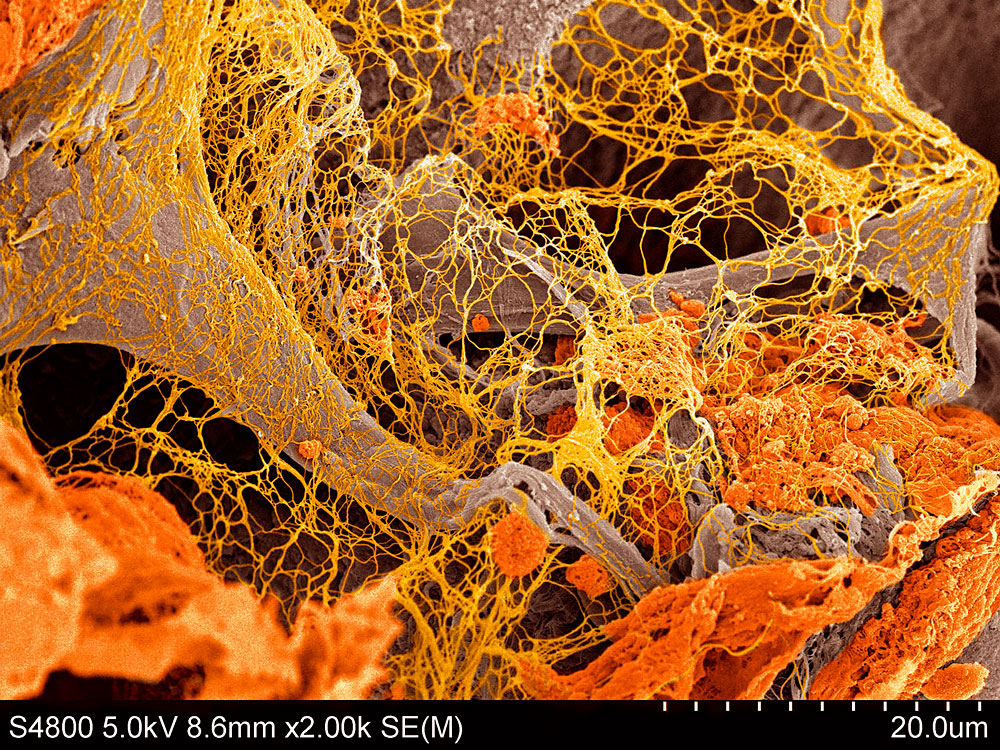The SGIker awards the prizes of their VII Scientific Photography Contest (2017/02/22)
First publication date: 23/02/2017

Gorka Orive and Erlantz Lizundia, winners of the VII SGIker Scientific Photography Contest
The images "Endogenous bioactive scaffold" by Gorka Orive and Erlantz Lizundia's "Sea of cellulose" were the winners of the 7th edition of the General Scientific Services Research Competition, SGIker, in the modalities of Sciences of Life and Science and Technology Materials, respectively.
The awards ceremony took place on February 17th, 2017, in the Meeting Room of the Central Library of the Bizkaia Campus (Leioa area), under the chairmanship of the Vice-Rector of Research of the UPV/EHU, Professor José Luis Martín , The director of the SGIker, Professor Maribel Arriortua, and the Professor of the Faculty of Medicine and Dentistry, Professor Juan Miguel Aréchaga. At the event, attended by numerous publics, the authors of the winning photographs have explained the meaning and the Process of creation of its works, and has been delivered the diploma and a latest generation tablet.
On this occasion, the jury, chaired by the Vice Rector of Research and made up of experts in the different scientific areas involved, had to choose the winning photographs from a total of 58 images submitted to the competition by 39 researchers, of which a 59% have done so in the field of Life Sciences, and 41% in Science and Technology Materials. As in previous editions, the decision of the Jury has been especially difficult due to the high quality of the works presented, highlighting those awarded for their visual impact, technical difficulty, scientific result, originality, design and artistic perspective and style didactic of each one.
The image taken by researcher Gorka Orive of the BTI Biotechnology Institute's "Endogenous bioactive scaffold" shows a new biomaterial based on growth factor rich plasma (PRGF) technology, provides a three-dimensional biomechanically stable matrix (Orange color) rich in fibrin and growth factors (yellow) that make it ideal to house resident patient cells (gray). The components of the biomaterial come from the patient's own blood so its 100% autologous nature guarantees the biocompatibility and the absence of adverse effects after its implantation. In the image we can observe a culture of fibroblasts growing and proliferating inside the new biomaterial using, as support, the three-dimensional protein matrix of PRGF, and nourishing from the growth factors released by the platelet aggregates that are distributed along the fibrin network. The image has been colored by the graphic design department of BTI Biotechnology Institute to differentiate, with greater clarity, the different structures. The image has been recorded in an Scanning Electron Microscope (SEM) of the SGIker.
In the Science and Technology of Materials category, the winning work, "Sea of cellulose" by the researcher Erlantz Lizundia, from the Department of Graphic Expression and Engineering Projects of the UPV/EHU, exhibits the morphology of the deposition of a thin layer of Copper (Cu) on a cellulose substrate. The deposition was carried out by means of the "DC-sputtering" technique, which by means of the formation of a plasma (of argon in this case) allows to create films of nanometric thicknesses on different types of substrates. For that study, a copper layer 200nm thick (right zone) has been deposited on a membrane composed of cellulose nanofibers (known by the term "nanopapel"), which is discovered in the left part of the image. The use of a biodegradable, inexpensive and renewable material such as cellulose as a carrier for different types of conductive materials represents an enormous advance from the environmental and economic point of view, since these materials are highly sustainable compared to materials that are used today. Thus, the possibility of manufacturing nanopapel through industrially scalable conditions will greatly contribute to the development of a green society by replacing materials derived from petroleum by renewable materials. In the not too distant future we will be able to see nanopapel / Cu films in flexible electronics and telecommunication engineering applications. The image was taken with an Scanning Electron Microscope (SEM) of the SGIker.
In the area of Science of Life, the expert commission has been formed by doctors: Jon Arluzea (Department of Cell Biology and Histology), Shira Knafo (Department of Biochemistry and Molecular Biology), Oier Echeveste Applied Chemistry), Ana Zubiaga (Department of Genetics, Physical Anthropology and Animal Physiology), Nerea Legarreta (Department of Drawing, Faculty of BBAA).
In the field of Materials Science and Technology, the jury was composed of doctors: Gotzon Madariaga (Physics Department of Condensed Matter), Arantza Eceiza (Department of Chemical and Environmental Engineering), Oier Echeveste (Applied Chemistry Department), Nerea Legarreta (Department of Drawing, Faculty of BBAA).
All photographs submitted to the contest can be viewed in the following web gallery. SGIker is grateful to the entire research community for their interest in participating in this new edition of the Scientific Photography Contest.
Image gallery
-

Maribel Arriortua, SGIker Director, José Luis Martín González, Vice-Rector for Research, and Juan Miguel Aréchaga Professor of the Faculty of Medicine -

Finalists of the photography contest -

Attendees at the awards ceremony -

Attendees at the awards ceremony -

Attendees at the awards ceremony -

Finalists and attendees of the awards ceremony -

Juan Miguel Aréchaga, Professor of the Faculty of Medicine -

Winning Photo of the Life Sciences Area -

Award of the winner of the Life Science Area -

Award of the winner of the Life Science Area -

Speech from the winner of the Life Sciences Area -

Finalists in the awards ceremony -

Winner in the Area of Sciences and Technology of Materials -

Photo of group of Contest participants -

Contest Winners -

Photo of group of Contest participants -

Winning photo of the Materials Science and Technology Area -

Speech from the winner of the Materials Science and Technology Area -

Maribel Arriortua, SGIker Director, José Luis Martín González, Vice-Rector for Research, and Juan Miguel Aréchaga Professor of the Faculty of Medicine

